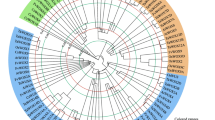Abstract
NADPH:cytochrome P450 reductase (CPR) is essential for the activation of cytochrome P450 enzymes, which are involved in a wide variety of metabolic pathways in plants, including those related to defence responses. In the subtropical plant Catharanthus roseus several cytochrome P450 enzymes operate in the biosynthesis of defence-related terpenoid indole alkaloids (TIAs). In agreement with the importance of CPR in defence, Cpr mRNA levels in C. roseus were found to be enhanced by fungal elicitor preparations that also induce TIA biosynthesis and P450 gene expression. Here we describe the isolation of a C. roseus genomic DNA clone covering the 5′ part of the Cpr gene and 1.6-kb of upstream sequences. Mapping of the transcription start site showed the untranslated leader sequence is approximately 280 bp long. To study the control of gene expression by the Cpr promoter, transcriptional fusions between Cpr promoter fragments and the gusA reporter gene were generated and their expression was analyzed in stably transformed tobacco plants. The Cpr promoter fragment extending from −1510 to −8, with respect to the ATG start codon, conferred basal and elicitor-inducible expression on the gusA reporter gene, strongly indicating that the Cpr gene of C. roseus is indeed controlled by this promoter region. Progressive deletion from the 5′ end of the promoter to position −632 had little effect on gusA expression. However, deletion to position −366 resulted in a complete loss of basal activity and largely eliminated elicitor-induced expression, indicating that the region from −632 to −366 contains the main transcription-enhancing cis-regulatory sequences. Electrophoretic mobility shift assays with tobacco nuclear extracts showed that binding sites for nuclear factor GT-1 are redundant in the Cpr promoter, but absent from the downstream part of the leader sequence. The presence of strong GT-1 binding sites in the main enhancer region (−632 to −366), is suggestive of a functional role for this factor in basal expression and elicitor responsiveness of the Cpr promoter.
Similar content being viewed by others
Author information
Authors and Affiliations
Additional information
Received: 18 November 1996 / Accepted: 2 August 1997
Rights and permissions
About this article
Cite this article
Cardoso, M., Meijer, A., Rueb, S. et al. A promoter region that controls basal and elicitor-inducible expression levels of the NADPH:cytochrome P450 reductase gene (Cpr ) from Catharanthus roseus binds nuclear factor GT-1. Mol Gen Genet 256, 674–681 (1997). https://doi.org/10.1007/PL00008617
Issue Date:
DOI: https://doi.org/10.1007/PL00008617




